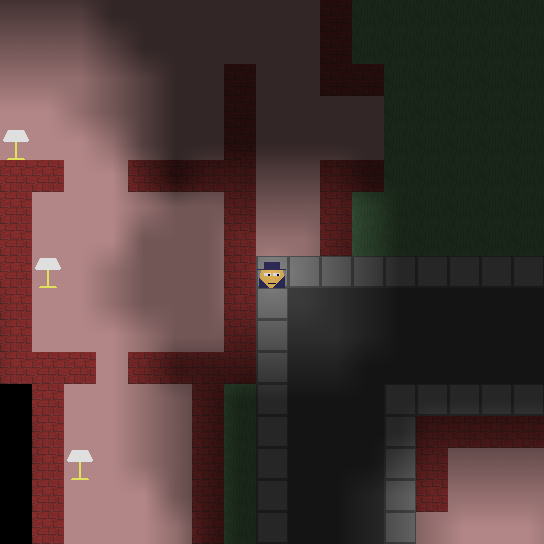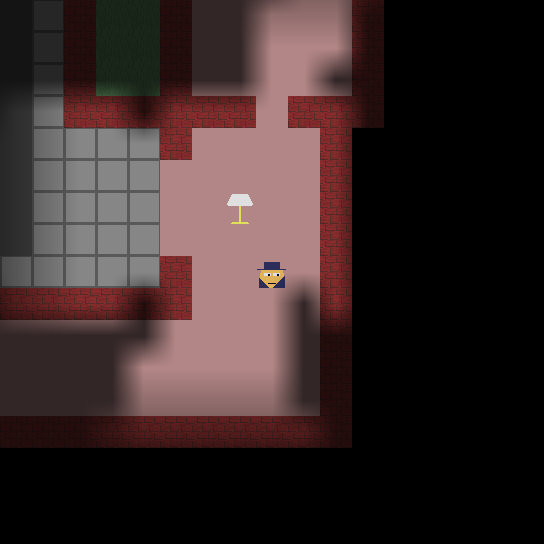
Dynamic Lighting |
||
An easy way to add dynamic lighting to your game. [More] |
To download this library for your Linux/Mac installation, enter this on your command line:
DreamDownload byond://Forum_account.DynamicLighting##version=7 Emulator users, in the BYOND pager go to File | Open Location and enter this URL:byond://Forum_account.DynamicLighting##version=7 |
The library lets you attach light sources to objects and automatically provides global dynamic lighting. It's as simple as:
// make a mob a light source The global illumination is automatically updated as the mob moves around. Light sources can also be attached to non-moving objects. Version 7 (posted 03-18-2012) • Changed how lighting is initialized. The lighting.init() proc is no longer used to set the icon, instead you just set lighting.icon directly. The init() proc initializes lighting. Any argument passed to it is a z level to be initialized, if no z levels are specified, lighting is initialized for all z levels. • Changed how light sources work. Previously you could set their radius and intensity vars directly. It took extra CPU usage to detect these changes so now you have to use the radius() and intensity() procs to set these values. This way lighting is only recalculated when it's absolutely necessary • Reorganized the code for the /light object. It now has a proc called loop() that is called by the lighting object's central loop. This proc checks for changes and calls apply(). The apply() proc removes the light's current effect and applies the updated effect. • Added the intensity argument to the /light object's constructor and re-named the radius arg to be called "radius". Both are optional (the default is radius = 3, intensity = 1) • Added a check so that shading.update() is only called when the lum value has changed in a way that will cause the icon_state to change. For example, a change from 0 to 0.1 will still use the same state and won't cause an update to occur. • Removed the shading.update() proc and made it inline. It was being called so many times that the overhead was significant. Profiling shows this change decreased the CPU time used by the light.apply() proc by 15%. • Changed the default light.lum proc to avoid unnecessary calls to sqrt(). Profiling shows this reduced the average CPU time of the light.effect() proc by about 20% and the average CPU time of light.apply() by 17%. • Added the light.ambient() proc which can be used to change a light's ambient level. Version 6 • Added the lighting.ambient var which can be used to set an ambient light level. If you change its value at runtime, it won't take effect until a tile is updated. Because the change would effect every tile, forcing every tile to update will often be too taxing on the CPU. • A new demo called "day-night-demo" was added to show how to use the new lighting.ambient var to create a day/night cycle. Version 5 • Changed the light.intensity var so it's now on the 0...1 scale. A value of 1 will make the center of the lighted area be at the maximum brightness regardless of the number of levels of shade you have. • Changed the light.lum() proc to take pixel offsets into account (based on step_x and step_y) when computing distances. This means that light sources using pixel movement will cause updates to illumination with every step they take, instead of causing updates only when they transition to another turf. • Added the lighting.pixel_movement var which is used to determine if pixel offsets are taken into account. By default this is enabled, but you can set light.pixel_movement = 0 to make light sources update tile-by-tile, even when using pixel movement. Version 4 • Changed the way dynamic lighting is initialized, instead of calling new() to initialize it, you call init() and pass init the icon file to use. You call the same init() proc to initialize a z level - you can pass any number of z levels as arguments or pass nothing to make it initialize all z levels. • Changed the /light_source object to just be /light • Previously, each light_source object had a loop that executed every tick, this loop was moved to be a single global loop in the /Lighting object for performance reasons. • Shading objects can now have decimal lum values (ex: 3.5) and will automatically be rounded to the nearest integer. • Added some detail to the icons used in the demo and created a separate icon file with simpler graphics. Switch between the two icon files in demo\demo.dm to see how much better the lighting effects look when the turfs have more detailed icons. • Added the light.intensity var which can be used to control the intensity of a light. • Changed the default light.lum() proc to take into account the radius and intensity vars, the default provides a circular area of light with a value equal to the intensity var at the center and fading to zero at the edges. • Updated each demo to have verbs for increasing and decreasing the light's intensity. Version 3 • Replaced the world.illumination and atom.light procs with the light_source.lum and light_source.effect procs respectively. This lets you more easily extend the lighting behavior by creating child types of /light_source, see customization-demo for an example. Version 2 • Changed the /LightSource datum to be /light_source and made it a child of /obj so they have positions on the map. • Made each /light_source object have a loop to check for changes even if the light source isn't attached to a movable atom. This is necessary for implementing shadows and lets you change its vars directly - instead of using the light's radius() proc to change its radius, just set the radius var directly (ex: light.radius += 1) • Added the shadows-demo demo which shows how light sources can be made to cast shadows by overriding the atom/light() proc. Instead of just returning the basic circular range of light, the light() proc in the demo does some visibility calculations so that opaque objects block light. • Added the world.illumination() proc which takes two atoms and a radius and returns the illumination value based on the distance between atoms and the radius of the light source. This way you can override atom/light() but still use the same illumination calculation, or you can override illumination() and keep the same atom/light() proc. Version 1 • Initial version |
FIREking: (Nov 23 2012, 1:22 pm)
Also, is this supposed to happen?
 FIREking: (Nov 23 2012, 12:12 am)
Also, your lights don't handle what should happen when they are deleted. I suggest:
light FIREking: (Nov 6 2012, 3:46 pm)
Carnwennan wrote:
You can fix the light-strips by setting the mob.sight |= SEE_PIXELS flag. > proc/lum(atom/a) This doesn't scale with different icon-sizes other than 32. FIREking: (Nov 6 2012, 3:45 pm)
It looks like either the light generation or the shade placement can't do anything over 8 states. I'm getting "flipped edges" in most cases...
http://i.imgur.com/Rz3r4.png Edit: this turned out to be my fault. |
Copyright © 2025 BYOND Software.
All rights reserved.





Unfortunately, if a turf gets "deleted" (turfs don't really get deleted, they just morph into another turf), the shading for that specific turf goes whacky...
I've tried just about everything I can think of and I can't fix it!
Also, as seen above, the opaque effect does something weird at the edge of the map.